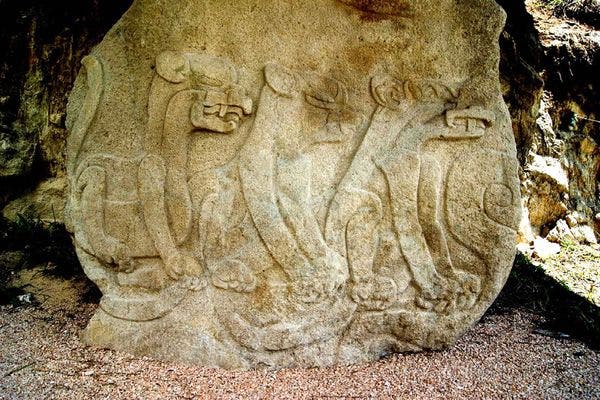
Archeologists unearthed from Mexico’s underground a spectacular Olmec-style stone carving depicting three sitting felines, dated from 700 B.C.
Dubbed the “Triad of Felines” by the archeologists who first discovered the monolith, the carving was found just 60 miles from Mexico City in Chalcatzingo, a famous archeological site known for its numerous Olmec culture artifacts found along the years. Since 1935, 40 large stone carvings have been unearthed in the area alone.
The Olmec civilization occupied today’s south-central Mexico region from about 1500 to 400 B.C, and are considered to be the first Mesoamerican civilization, responsible for laying many of the foundations for the civilizations that followed, including the Maya. A big part of their culture, besides religion (Olmec’s practiced bloodletting and human sacrifices), was art, as evidenced by the numerous exquisite artifacts found by archeologists.
A pilgrimage billboard
It took months of painstaking work for the archeologists to recondition and piece together the 11 eleven broken pieces of stone, like a giant, albeit heavy, puzzle. Interestingly enough, the researchers who’ve been studying the artifact came up with an interesting theory explaining the collection of carvings that dotted the Chalcatzingo landscape, found in the past few decades. They hypothesize that these carvings were actually like giant billboard like figures, scattered across the landscape, guiding people around a pilgrimage route.
“One of our hypotheses is that, in the time from 800 to 500 B.C., there was a frieze along the entire Cerro Chalcatzingo,” or “Chalcatzingo hill,” project member Mario Cordova Tello, an archaeologist with Mexico’s National Institute of Anthropology and History (INAH), said in a statement.
The inhabitants of ancient Chalcatzingo weren’t Olmec though, at least not techniqually, but mearely influnced. Olmec carvings tend to be three-dimensional, but the Triad of Felines has been carved flat, in the manner of other Chalcatzingo surfaced findings. Still this particular monolith has been clearly influnced by Olmec culture, as it can be seen in the various symbols.
For example, the cats depicted in the monolith appear to have supernatural traits, such as flaming eyebrows and stylized mouths, very reminiscent of traditional Olmec masks. Taken particularly, the “Triad of Felines” can be considered unique from other similar carvings depicting big cats, as it portrays them sitting.
Big cats, like jaguars, are a common motive in Olmec art, culture and religion, but their exact mythological significance remains vague for archeologists.
“Something having to do with mythology is being expressed in these carvings … but I am still trying to figure out exactly what it is,” Grove said. “Not a lot is known about Olmec religion.”


